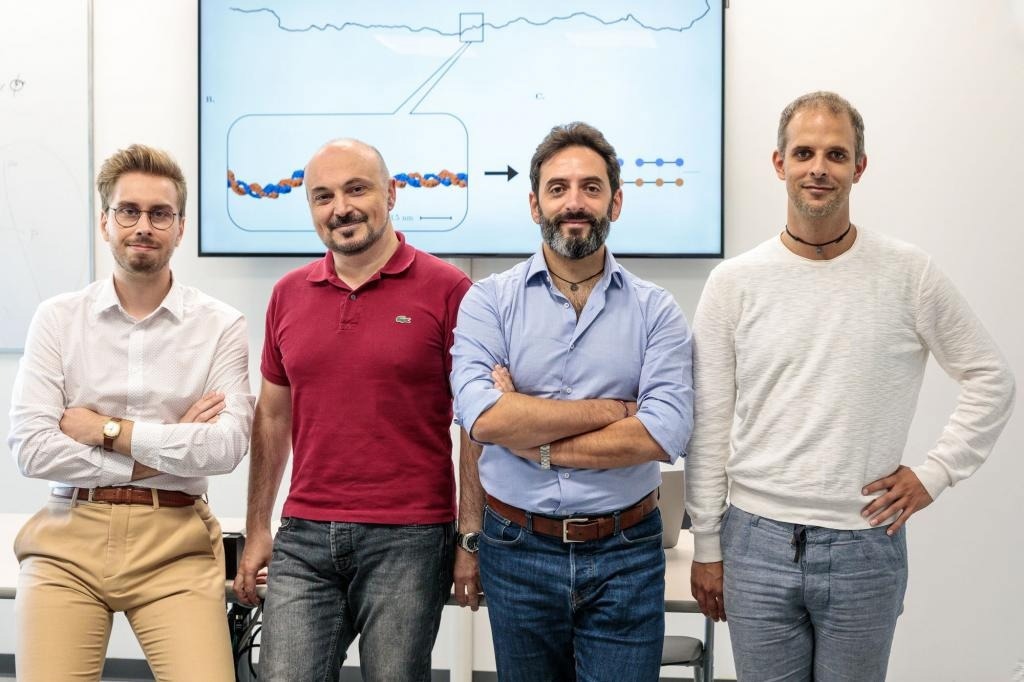Reviewed by Danielle Ellis, B.Sc.Aug 9 2023
Investigators from the University of Trento’s Physics Department discovered a link between the effect of radiation on DNA and the time when the damaged molecule breaks irreversibly. Their investigation opens up new avenues for cancer treatment applications in the medical, biological, and radiotherapeutic fields. The research was published in the Biophysical Journal.

Manuel Micheloni, Gianluca Lattanzi, Raffaello Potestio, Lorenzo Petrolli. Image Credit: University of Trento
Humans are exposed to ionizing radiation more frequently: while bathing in the sun, which emanates UV rays, or when X-Rayed, or on an intercontinental flight that is 10,000 m above sea level. This type of radiation is potentially harmful to DNA because it can damage, break, or modify it, resulting in tumor formation.
A team of scientists guided by Raffaello Potestio and including Manuel Micheloni, Lorenzo Petrolli, and Gianluca Lattanzi researched the ionizing radiation-induced DNA rupture. They calculated the average time between radiation exposure and DNA strand rupture. They discovered that the greater the distance between damaged areas of DNA, the longer the DNA structure remains intact. As a result, the cell has more time to repair itself.
Computational Models
The investigators developed a computer simulation of a double-stranded DNA sequence, similar to a video game. They ascertained the filament’s behavior after simulating radiation damage. The rupture known as a double-strand break (DSB), which is the interruption of the structural and chemical continuity of the DNA skeleton in the two complementary strands, is one of the most dangerous consequences of the impact of radiation on DNA.
At the cellular level, this type of injury can have serious consequences. Researchers have determined that strands do not break instantly and that the time it takes for a strand to break rises significantly with the distance between the breaks in the DNA strands. The researchers were able to develop a law for average rupture times based on the distance between strand breaks.
This information is crucial because it probably affects the effectiveness of DNA repair processes.”
Raffaello Potestio, Physics Department, University of Trento
Rupture Time and Repair Time
Cells have a complex enzymatic system for the control and “maintenance” of DNA, which is induced when it obtains signals of injury. This mechanism, however, is not activated immediately after the damage, and a pause can interfere with the cell’s normal functioning.
Sequence modification may have no effect if it occurs as a result of one or more synonymous mutations that result in the synthesis of the same protein. If there are significant changes in the DNA sequence or errors in the repair process, the cell will commit suicide (a process known as “apoptosis”) because it realizes the sequence is incorrect or irreparably damaged.
In the worst case, however, the cell manages to repair the DNA chain’s integrity, but this could result in a mutation or a change in the nucleotide sequence, which could cause dysfunctional behavior, genetic changes, chromosomal mutations, or the development of cancer.
From Computers Simulation to Practice
According to the study’s authors, this work is important for the field of radiobiology and is a first step toward potential advancements in medical treatment and prevention. The use of numerical simulation methods that can be replicated experimentally makes this study unique; one of the researchers’ goals is to transfer the simulation from the computer to the laboratory.
Long-term development of novel, more precise radiotherapeutic approaches depends on the understanding of how radiation affects DNA.
This study has a dual and complementary purpose. On the one hand, to understand the mechanisms that cause cellular damage to prevent or limit such damage and, on the other, to find the best way to cause the greatest possible damage. This is important, for example, in the field of proton therapy, which uses ionizing radiation, specifically protons, to target cancer cells and kill them.”
Raffaello Potestio, Physics Department, University of Trento
“Radiotherapy encompasses a series of more complex issues such as, for example, precisely locating the radiation deposited in cancer tissues, so as to prevent the rays from targeting healthy cells that could be damaged. The more we understand the consequences of radiation and the rupture of DNA strands, the more we'll be prepared to develop other treatments and mitigate side effects,” concluded Potestio.
Source:
Journal reference:
Micheloni, M., et al. (2023). Kinetics of radiation-induced DNA double-strand breaks through coarse-grained simulations. Biophysical Journal. doi.org/10.1016/j.bpj.2023.07.008.